February 2023 | Interview with Diane Barker, Artist, Photographer, and Chronicler of Tibetans – Part I
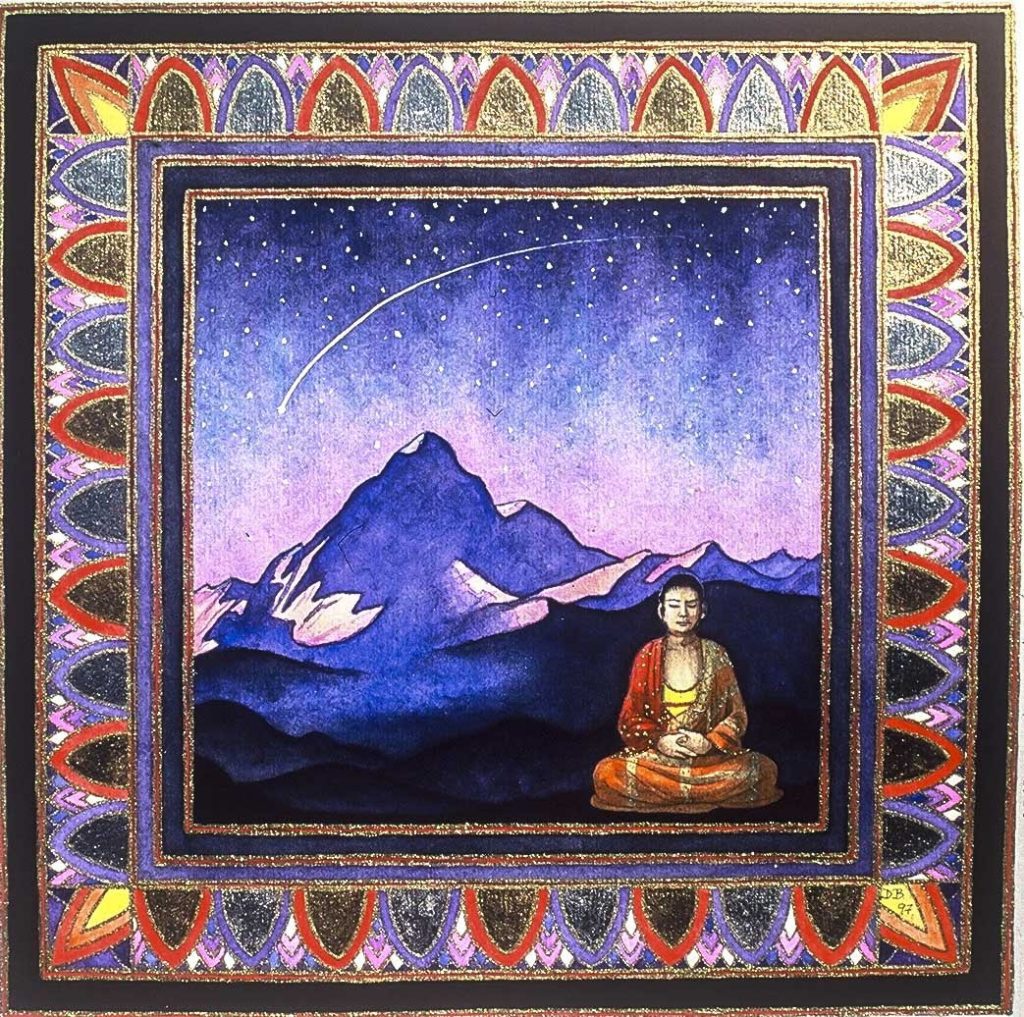
I met Diane almost 40 years ago when we were going to the same small art classes in people’s homes and attended the same meditation group in London. I saw her blossom as an artist, painting these incredible mandalas. But only much, much later, did I learn about her relationship to the people of Tibet, her photographic mission, and Heart of Asia, the charity she co-founded.
Diane lives in a village in Worcestershire, England, in the same house she was born in.
We chatted by phone in December, and Diane mentioned the Mamos Puja ceremony. I was completely fascinated and amazed. Here is some background to this event.
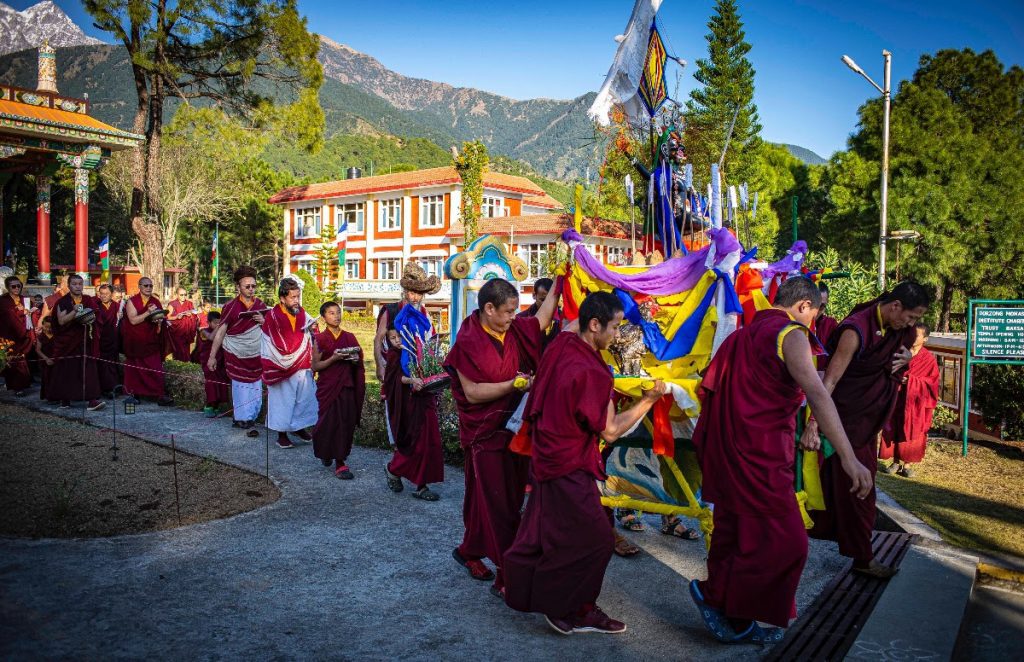
The Mamos Puja
When in conversation in 2011 with Choegyal Rinpoche, a gently retiring Drukpa Kargyu Tibetan Rinpoche, Diane Barker (Artist & Director of the British Charity Heart of Asia) was very moved to hear of the Mamos Puja, an ancient Tibetan ritual that has not been performed for over a century. In former times it had been a ritual used to help keep society in harmony with the natural world.
This ceremony will now take place for a fifth time in India in June 2023. It will be a closed puja (prayer ceremony) but those involved request ‘people of faith’ to hold the practitioners and our world in prayer during this Puja.
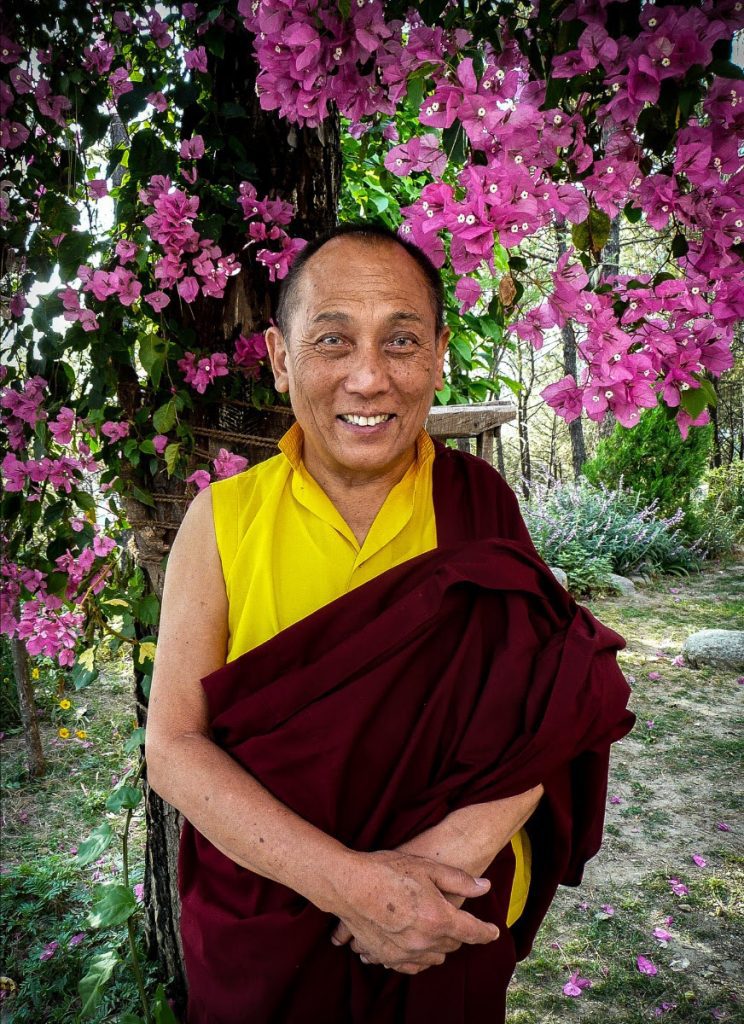
Rinpoche’s explanation of the Mamos Puja is as follows:
Disasters and suffering are increasing all over the world, despite humanity’s material progress. Unending greed and hatred are disturbing the whole of existence without limit. Human minds are so disturbed by selfishness. Nature is suffering, and the consequence of this is to upset the whole living environment, which includes the most important forces behind all the Motherly supportive feminine forces.
The great realized ancient Masters of Tibetan Buddhism understood all this and advised the Tibetans to perform this ancient Mamos Puja in times of darkness.
The Mamos are the extremely powerful goddesses (described by Rinpoche as “feminine super nature”) abiding in earth, fire, wind, sea, mountains, and space, throughout our entire solar system. (Ma means Mother and Mo means female.) When nature is disturbed, the Mamos/mothers become disturbed, and then the earth becomes disturbed as a result. When the Mamos are upset, this also affects people’s minds. (Of course, this is because of our interconnectedness in the sacred web of life.) There is one example of a Mamo described in the “Life of Milarepa;” otherwise it would seem that there is nothing one can read about the Mamos anywhere that is translated into English.
In the “Life of Milarepa,” it is written that one of the very High Queen Goddesses of the Himalaya was sick, and invited Milarepa to give a blessing to heal her. Some people had done something negative (disrespectful) to the local environment and so the Goddess had become sick. As a result, the local people were also becoming sick and natural disasters were occurring. And so Milarepa gave the blessing to heal her. He also advised the local people not to disturb the natural environment, to maintain ethical behavior, and to perform prayers to bring blessings to the region. As they did so the area regained health and happiness and became free from natural disasters.
This puja is an ancient Tantric ritual practice that helps heal all the Mamos in the entire solar system. The ceremony calms down the Mamos’ irritation and gives healing blessings to them. This helps to stop wars by not allowing evil forces to arise in the minds of humanity, and helps to prevent epidemics and natural disasters.
During the Mamos Puja, the Rinpoche Masters, yogis, yoginis, Bhikhyus, Bhentes, and nuns meditate on a wrathful Buddha and use that practice to communicate with the Mamos. The meditators attract the Mamos’ attention and transmit blessings to them to soothe their aggression and help them calm down. They then inspire the Mamos to generate loving kindness and bring many of the Mamos to take a vow to bring peace, harmony, and health to the entire world.
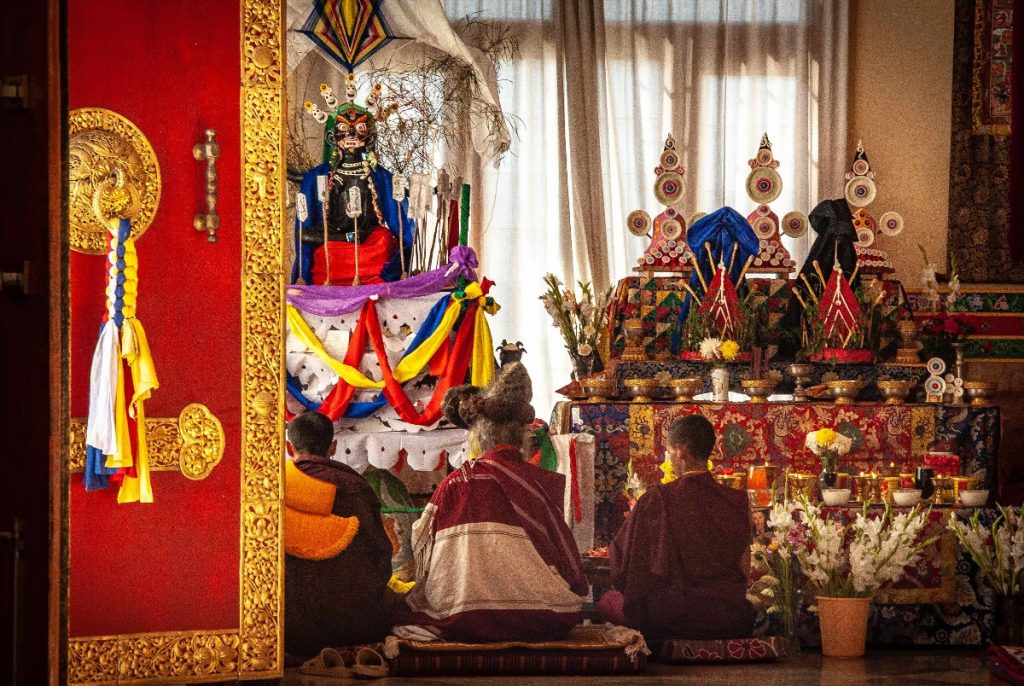
Rinpoche also said how he enjoyed reading The Return of the Feminine and the World Soul, by Llewellyn Vaughan-Lee, and how much he feels the importance of all human beings’ love, respect, and care for each other; and of all the joy of their differences; and of their shared love for the world at this time. He quoted from the book,
“Beyond our present ecological self-destruction, caused by industrial pollution, by the chemicals, toxins and particularly carbon that our civilization emits, lies our desire for material progress, the demon of consumerism and greed that walks with heavy boots over the sacred soil of our world. At the root of our predicament is a deep disregard for the environment and for the consequences of our actions, until it is too late. This is a product of a consciousness that is cut off from the natural world and its interconnectedness. It comes from an attitude that we are separate from the world around us and can do with the world what we want – an attitude that is unthinkable to indigenous people who respect and revere the physical world, and whose cultures protect the balance between humanity and nature.”
More Words Relevant to the Mamos Puja
“If you will think of ourselves as coming out of the earth, rather than having been thrown in here from somewhere else, you see that we are the earth, we are the consciousness of the earth. These are the eyes of the earth. And this is the voice of the earth.”
Joseph Campbell, “The Power of Myth”
“Holy Mother Earth, the trees and all nature, are witnesses to your thoughts and deeds.”
A Winnebago saying
“…I am the murmur of leaves rustling.
I am the rays of the sun,
I am the beam of the moon and stars,
I am the power of trees growing,
I am the bud breaking into blossom…”
The Black Book of Carmarthen
“Indigenous teachings embrace the divine feminine in a way that is crucial for healing ourselves and the earth. For thousands of years, it has been known that everything that exists in this world is alive and has a spirit. We are connected to a web of life that is impacted by the behavior of all that is alive…”
Sandra Ingerman (Contemporary Shaman)
“…the World Soul could express its dark side, like the Kali side of the feminine, and become incredibly destructive. That is a very real possibility. Because as we have forgotten the world is a living being, we have also forgotten the powers of creation can get angry. That forgetting belongs to the masculine myth of domination and control that says we can control nature. We believe that nothing too bad can happen, since, as we’re told, nature is not really alive. But this is not so. This is why in ancient times, the people were very careful in their relationship to nature and the spirits of nature, why they learned how to talk to nature and to be present within nature, and how to listen to it, how to make a living relationship with it. Now you go out on the freeways and the shopping malls and the TV channels and it isn’t there; there isn’t even memory of it, let alone any sense of how to bring it alive…”
“We can include the Earth in our prayers and in our awareness…If we have any duty to the whole, if there is anything we owe to creation, we should remember the world in our prayers and meditation. The world’s soul is present as part of us, crying out for our remembrance.
Llewellyn Vaughan- Lee
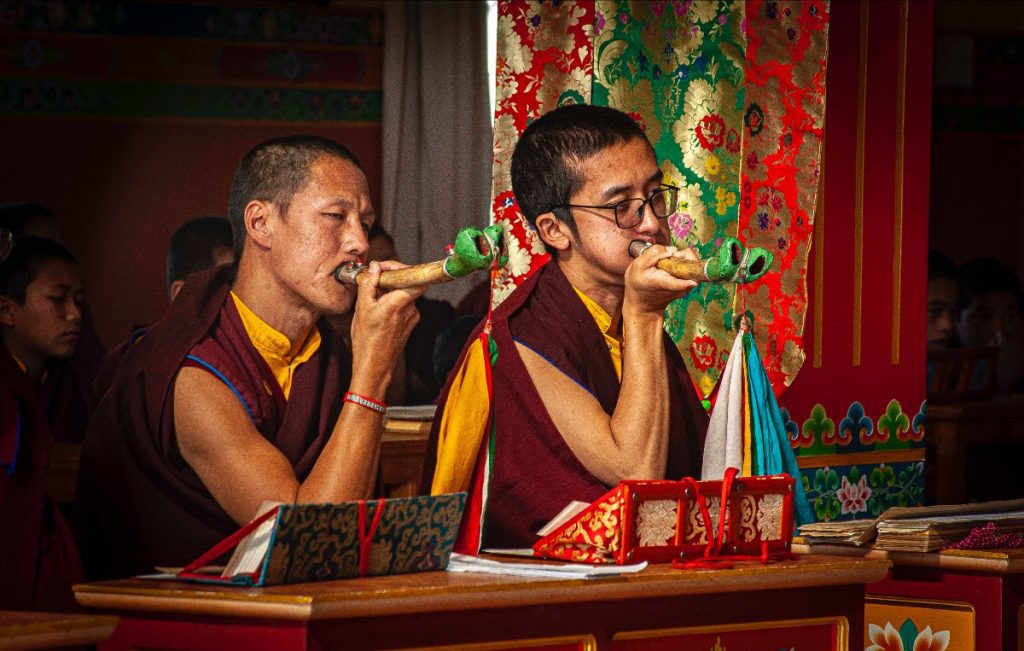
My interview with Diane took place in January on Zoom. I began by asking her about the Mamos Puja.
The last Mamos Puja, which was the 4th since 2013, was held in late December 2019. It was a “Grand” Puja, involving a lot more monks and nuns than in the previous ones. I sat at the back of the Temple. There were a few Westerners, whilst at the previous Pujas I’d been the only Westerner and there were no lay people present from the local community. The puja was led by a Togden Yogi from Tashi Jong, and due to the greater number of practitioners, it felt very powerful. Beforehand, the monks spent days creating torma and a number of symbolic figures from butter and tsampa (made from roasted barley and ground into flour), representing the Queen of the Mamos (astride a globe of the world) and other beings, and these are placed on an altar as part of the ceremony, along with offerings of food and alcohol.
I wasn’t sure what to do as I’m not a Buddhist practitioner, so I meditated and visualized the Earth. At first, it appeared to me covered with obscurations, like grey clouds. Then gradually it appeared to me as very, very clear. It was quite curious. I described what I saw to Choegyal Rinpoche after the three days of puja, and asked him if perhaps I’d imagined what I’d seen. He answered, “No, no, that’s how the Puja works!”
I remember Mrs. Tweedie (our Teacher) saying back in the 1980s, “the Earth Goddess is angry.” It was after the Fukushima tsunami and nuclear disaster of 2011 that I was prompted to ask Rinpoche, “What do you do about these sorts of events in your tradition?” “We do the Mamos Puja,” he replied. It was that conversation that initiated these pujas in India in recent years.
We are privileged that we can support the 2023 Puja financially and through our prayers. In order for it to be a “Grand” Puja, and include more nuns as well as monks, money has to be raised, and Diane has given me the info needed to do that. Please find this info at the end of Part I. Thank you.
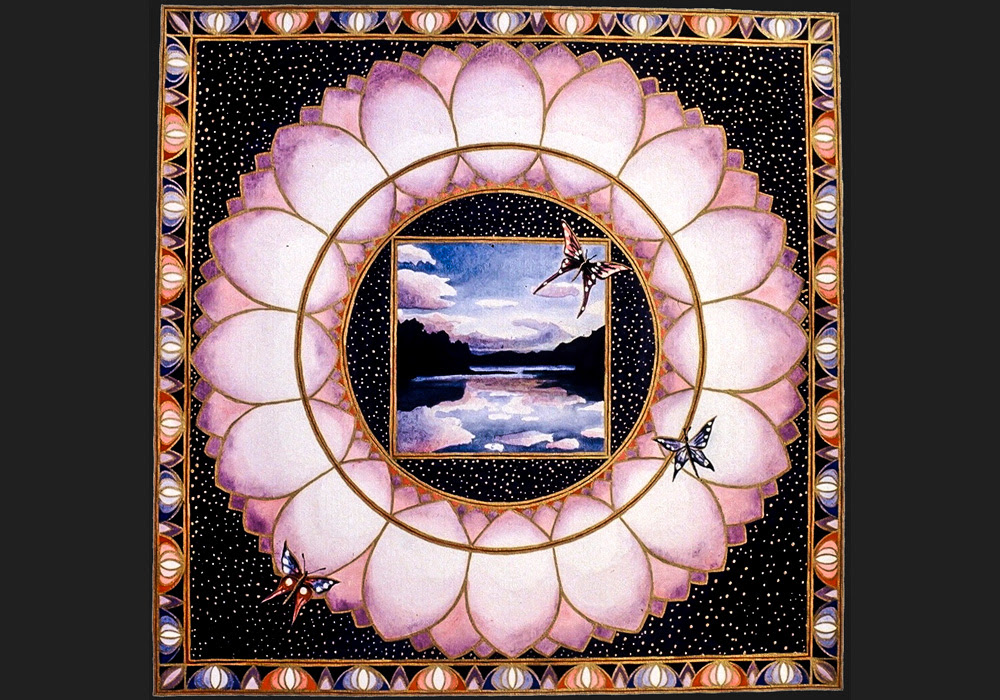
When I was 30, in 1982 I joined a drawing class that took place in Janet Jones’s house in Kilburn every Saturday. Led by Silva Wills. It was based on the extraordinary teaching methods of visionary artist Cecil Collins, and for me, it was life-changing, really releasing my pent-up creative energy – in fact, I couldn’t stop creating afterwards. I started making collages obsessively in a number of journals to show Janet, who was my counselor. After a while, she said, “Isn’t it time to start making your own images?” and gave me a box of her own old hand-made watercolors. And that is how I began as a painter. I then learned to make my own watercolors from plants and minerals with Maria Lancaster and Lynette Howells-Moore.
Mandala paintings streamed out of me. I began with images that were symbolic and clearly about my inner world, and then over time that focus moved out into the landscape of my birth village in Worcestershire, and also of the Welsh borders. They were really about my heart projected onto a landscape, and were surrounded by 4-line poems that I wrote. The paintings were like prayers, and many celebrated trees. Some were eventually published in a little book of days by East-West publications, The Eternal Land: A Book for Days to Remember.
A time came around 1991 when I felt that I didn’t know what else to say in paint and I went into a sort of in-between period, a kind of bardo between one creative phase and another. I was wandering the stacks in the local library when a book more or less jumped off a shelf into my hands! It was “My Land and My People,” the autobiography of His Holiness the Dalai Lama. By halfway into the book, I was completely in love with him and felt strongly that I wanted to meet him.
Shortly afterwards an old Buddhist friend brought two guys to look at my recent paintings. One bought a painting, and the other, well, we had an immediate connection. He was teaching English to monks at Rumtek monastery in Sikkim and we became friends. He invited me to come out to India. It was while I was in India, where he took me from one Tibetan Rinpoche to another in different locations, that I began photographing the Tibetan Lamas and the communities around them. He also managed to fix a private meeting for me with the Dalai Lama, and I gave him a copy of my little book of days. It was less than a year after I’d read his autobiography.

When I got back to England, I realized that I had a lot of photos of Tibetans. Then by chance, I came across a photo library focused on Tibetan culture – Tibet Images – and contacted Jane Moore, who ran it. She accepted many of my photos and encouraged me to take more for her library. In 1994 I went back to India and immersed myself in the Tibetan communities in Himachal, in northern India, receiving permission to photograph in all sorts of places, from the Tibetan Children’s village, to the Tibetan Hospital, lay people at their devotions, to even recording the State Oracle of Tibet in trance.
I also met Choegyal Rinpoche, my strongest Tibetan heart connection, on this journey, when I was commissioned to interview him about his beautiful non-traditional Tibetan paintings. He was then based in the small Tibetan community of Tashi Jong, gathered around Khampagar Monastery in the Kangra Valley of Himachal. From then on Tashi Jong drew me on all my subsequent travels to India.
From 1994 onwards I went to India every year with my camera and began to gather a large collection of photos documenting Tibetan life there. In 1997, I created a photo exhibition “Free Spirits: Tibet in Exile,” and began to tour it in the UK. In 1999 I was invited to show the work at the Center for Photography as an Art Form (India’s only publicly funded photo gallery at the time) in Mumbai, and friends I made there invited me to bring the work back the following year for the Festival of Tibet 2000.
After the festival in Mumbai, a Delhi publisher contacted me and commissioned me to photograph nomads in Ladakh, and so I headed there. I had absolutely no luck finding nomads (well, they tend to move around a lot and I had no idea where to look), and the deadline for delivering photos to the publishers came and went. I relaxed into enjoying my time in Leh – and then a friend said, I can get you to some Tibetan nomads living in the Changthang desert, and you need a permit as you will be going to a sensitive border area. I thought – well, too late for the publishers but well, why not.
I found myself in a vehicle with four Tibetan guys involved in census taking. We drove as far as we could by road, then veered off into the high-altitude desert. Eventually, we crested over a hill after many hours off trail in their four-wheel drive, and saw a white Tibetan picnic tent near a salt lake. Out of it emerged these glorious wild and earthy men, with long hair and earrings, wearing home-spun clothes and felt boots. They were the most traditional lay Tibetans that I’d ever come across and were so friendly and welcoming. They looked rather like first nation people in Edward Curtis’s photos, and I thought here is a beautiful earth-based culture still alive today. It was like falling in love.
I met their families and spent a week traveling around to different nomad groups in the area while the guys got on with the census (and drinking and playing cards!). I thought, These people are extraordinary. I have to go to Tibet and see what nomads are like there! A friend said “But Di, you don’t like camping and you don’t like being cold!” and I thought “I’m useless at languages – I’ll never learn Tibetan….”, but somehow, I felt an incredible pull to go.
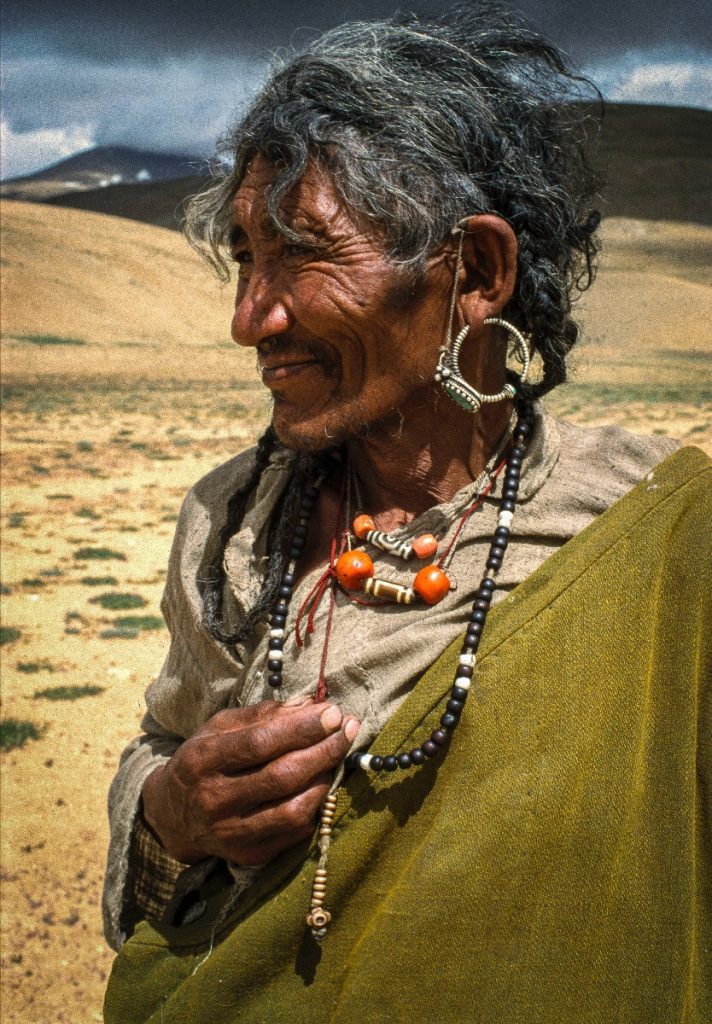
Please visit Diane Barker’s website to see more of her stunning photos and learn about her new book, Portraits of Tibet, including an outstanding book trailer. Portraits of Tibet is available internationally from bookdepository.com
Pregnant Air
Whipping wind and rain
hammering and echoing
in bending trees, clattering
on skylights, lashing
rooftops and power lines
with bounteous ease.
Rhythmically abating,
like the trough of a wave
before belting onto fence
and balustrade. Pelting
decks, a steady rumble
cascades, charges
pregnant air to spring
a rush of streams—
all is flow, all is awe,
while we shelter from the squall.
Revel in these powers
that holy earth displays—
our mountains of denial
taller than the Himalayas.
From At This Table
Receive the Earth-Love Newsletter, event invitations, and always a poem.
